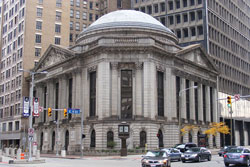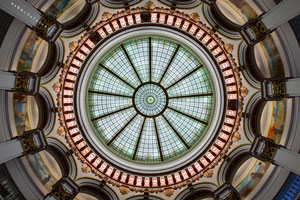Jennifer Coleman, Chair, Cleveland Landmarks Commission, architect, entrepreneur, Cleveland, Ohio
Jennifer Coleman, a native of Cleveland, Ohio, is a practicing architect, chair of the Cleveland Landmarks Commission, and founder of CityProwl digital walking tours. Coleman has more than 20 years of experience in the architecture field, and received her Bachelor of Architecture from Cornell University. She has worked on projects ranging from Laurel School's Fairmount Campus to the renovation of the Howard M. Metzenbaum Federal Courthouse. It was this project that inspired her to create CityProwl, which showcases some of Cleveland's hidden architectural gems. An active participant in her community, Coleman is additionally a member of the Group Plan Commission. She currently resides in the Fairfax neighborhood of Cleveland with her husband and son.
Cleveland Landmarks Commission, and founder of CityProwl digital walking tours. Coleman has more than 20 years of experience in the architecture field, and received her Bachelor of Architecture from Cornell University. She has worked on projects ranging from Laurel School's Fairmount Campus to the renovation of the Howard M. Metzenbaum Federal Courthouse. It was this project that inspired her to create CityProwl, which showcases some of Cleveland's hidden architectural gems. An active participant in her community, Coleman is additionally a member of the Group Plan Commission. She currently resides in the Fairfax neighborhood of Cleveland with her husband and son.
What led you to your field?
I came to preservation through my work as an architect for the last 24 years. Many of the projects I worked on here in Northeastern Ohio were renovations or restoration projects. I derived a great deal of satisfaction working on these projects to see buildings brought back to their former glory and able to be adapted to use in the 21st century. In 2006, I was appointed by the mayor of Cleveland to the Cleveland Landmarks Commission. In 2009, I became chair of the commission.
How does what you do relate to historic preservation?
The Landmarks Commission reviews proposed changes to a building or district that has applied for a building permit, if it has been designated a landmark by the city. The Commission also reviews nominations for landmarks and makes recommendations to the city for action. In the eight years that I have been on the Commission, I have seen lean times during the recession where many demolitions were requested due to the cost for building upkeep was prohibitive for some owners, to now, where there is more public interest in maintaining historic buildings, but sometimes economic development opportunities can both help or threaten their preservation. It is a delicate balance to weigh these factors.
Why do you think historic preservation matters?
One way to gauge the depth of the vitality of cities is to look at the variety of building styles and ages of the building stock. Cleveland is fortunate to be able to showcase a wide swath of its history in its buildings and homes, dating back to the early 19th century. These buildings show what we value and valued, the stories of the people that came to this city and country to share their craftsmanship and artistry in helping build the buildings, they show our hope of where we thought our goals would take the city. They also connect us to our ancestors, by being able to experience the same buildings that they did. No city should serve as a museum of one period in time but as a laboratory of its transformation over the years.
What courses do you recommend for students interested in this field?
I did not study preservation in college, so I'm not familiar with the course load. I would recommend taking elective courses in grant writing and communications.
Do you have a favorite preservation project? What about it made it special?


One project that is enchanting me right now is the renovation to the 1912 Cleveland Trust Rotunda (George Post) and 1972 Tower (Marcel Breuer) in downtown Cleveland. The complex of former bank and office buildings are being transformed into a hotel, apartments, and grocery store, after being vacant for more than 10 years. These buildings range in styles of neo-classical architecture to modern Brutalist. The project also highlights the transformation of Cleveland's downtown from a singularly business-centric to a multi-use live/work/play environment.
Can you tell us what you are working on right now?
On the preservation front, I'm working on helping as much as possible the Landmarks Commission keep up with its increased demand of services. The amount of designated landmarks and districts has increased greatly in the last decade, but the staff and resources have decreased. About 80 percent of Cleveland's building stock is eligible to be landmarked, but that is not feasible or advisable. Developing a preservation plan for the city that extends beyond landmarks would be a wonderful thing for the city.
How do you think the national historic preservation programs help your community?
Cleveland has been benefitting greatly from the state and local tax credit programs, which have been fueling much of the development in the downtown area and our neighborhoods. In fact, we are running out of buildings that can qualify! Without the programs, I am not sure that we would be seeing many of the projects being able to be financed in a timely fashion or at all.
Do you have advice for novice preservationists?
Do not be afraid to work with your city landmarks and preservation departments. There are many new tools that are being used for documentation that the municipalities are not aware of. Also, working on ways to engage citizens on the importance of preservation and how they can positively contribute to their neighborhood's vibrancy is important.
The ACHP's mission is "preserving America's heritage;" can you give us an example of how your community is preserving its heritage?
Cleveland has been making an effort to survey our legacy neighborhoods. This not only helps us keep an accurate inventory of our historic buildings but allows the local leaders, stakeholders, and citizens to realize the value of these buildings, many of which have been hiding in plain sight for decades, slowly falling into ruin. It can be a challenge for some communities that are battling many economic challenges to recognize the importance of the upkeep of its building stock, but education is a valuable tool and possible way to uplift the neighborhoods.
How does architecture play a role in the preservation field?
Architecture for the most part is the reason for preservation. The buildings and structures that have been built by man through the ages are the focus of most preservation efforts. A thorough knowledge of the architectural styles and forms of buildings, its surrounding context, placement in the architect's or designer's overall body of work (if known) are all important architecture-based criteria that a preservationist should know in evaluating historic buildings. Not all architects are preservationists but many do work on a diverse array of projects whose goal is to restore historic buildings and allow them to be adaptable to this century's complex needs.
Read more Q&A stories about the preservationists in your neighborhood!